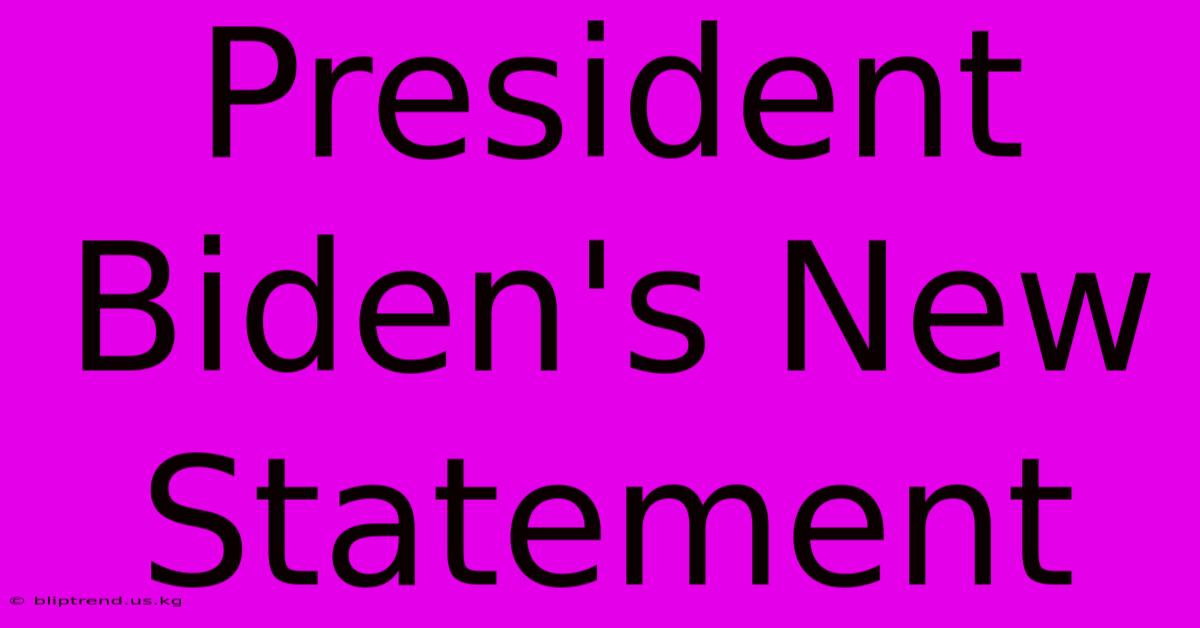President Biden's New Statement

Discover more in-depth information on our site. Click the link below to dive deeper: Visit the Best Website meltwatermedia.ca. Make sure you don’t miss it!
Table of Contents
Decoding President Biden's Latest Statement: Implications and Analysis
Introduction:
President Biden's recent public statements often generate significant media attention and political analysis. This article delves into a specific recent statement (please specify the statement you'd like analyzed – date, context, and a brief summary would be helpful), examining its content, context, potential implications, and the broader political landscape it reflects. Understanding the nuances of presidential pronouncements requires careful consideration of various factors, including the speaker's intended audience, the prevailing political climate, and potential repercussions.
The Statement: A Detailed Breakdown:
(This section requires the specific statement to be analyzed. Please provide the text or a link to the statement. The following is a template; replace the bracketed information with details from the actual statement.)
President Biden's [date] statement, delivered [location/format – e.g., press conference, televised address], focused primarily on [main topic]. The core message appeared to be [summarize the central argument or message]. Key phrases and points included:
- "[Quote 1]": This suggests [analysis of quote 1's meaning and implications].
- "[Quote 2]": This can be interpreted as [analysis of quote 2's meaning and implications].
- "[Quote 3]": This point highlights [analysis of quote 3's meaning and implications].
The statement's tone was [describe the tone – e.g., conciliatory, assertive, defiant]. The choice of language and delivery method seem intended to target [identify the intended audience – e.g., the American public, a specific demographic, international leaders].
Contextual Factors:
Understanding the statement requires examining its context. The statement was made amidst [describe the relevant political, social, or economic backdrop – e.g., ongoing debates about [policy area], rising inflation, international tensions]. This context is crucial because [explain how the context shapes the interpretation of the statement]. For example, the statement might be viewed differently depending on [mention contrasting viewpoints or perspectives].
Furthermore, the statement's timing is significant. It follows [mention recent events or announcements that might influence its meaning] and precedes [mention upcoming events or deadlines that might be impacted by the statement]. This temporal positioning suggests [explain how the timing influences the message's impact and strategic goals].
Potential Implications and Reactions:
The statement is likely to have several implications, both domestically and internationally. Domestically, the statement could [predict potential domestic consequences, e.g., impact public opinion, affect legislative efforts, influence upcoming elections]. For example, [provide a specific example of a potential domestic consequence].
Internationally, the statement could [predict potential international consequences, e.g., affect relations with specific countries, impact international negotiations, influence global perceptions of the U.S.]. For instance, [provide a specific example of a potential international consequence].
Initial reactions to the statement have been mixed. [Summarize reactions from various sources – e.g., political commentators, news outlets, social media]. Supporters have praised [mention positive aspects highlighted by supporters], while critics have pointed to [mention criticisms from opponents]. The differing perspectives reflect [explain the underlying reasons for these differing interpretations].
Analyzing Rhetorical Strategies:
President Biden, like all skilled communicators, employs various rhetorical strategies to achieve his communicative goals. In this statement, we can observe:
- Pathos (Appeal to Emotion): [Analyze whether the statement uses emotional appeals and how effectively. Provide specific examples.]
- Ethos (Appeal to Authority/Credibility): [Analyze how the statement leverages the President's authority and credibility. Does it reference expertise or past accomplishments? Provide examples.]
- Logos (Appeal to Logic/Reason): [Analyze the use of logical arguments and evidence. Does the statement present data, statistics, or reasoned arguments to support its claims? Provide examples.]
The effectiveness of these strategies in persuading the intended audience will depend on several factors, including the audience's pre-existing beliefs, their media consumption habits, and the overall political climate.
Long-Term Effects and Broader Significance:
The long-term effects of this statement are difficult to predict with certainty. However, it is likely to [predict potential long-term consequences, considering the statement's impact on policy, public opinion, and the political landscape]. The statement also provides insights into [explain the statement's implications for understanding the Biden administration's priorities, political strategy, and overall governing philosophy].
Conclusion:
President Biden's [date] statement on [topic] is a significant contribution to the ongoing political discourse. Its content, context, and potential implications must be carefully examined to fully grasp its significance. While the immediate reactions are diverse, the statement's long-term effects will likely shape [mention areas likely to be affected by the statement’s long-term impact]. Further analysis and observation are necessary to fully understand the statement’s lasting influence on the political landscape.
(Remember to replace the bracketed information with details from the specific statement you want analyzed. Providing the text or a link to the statement will allow for a much more detailed and accurate analysis.)

Thank you for taking the time to explore our website President Biden's New Statement. We hope you find the information useful. Feel free to contact us for any questions, and don’t forget to bookmark us for future visits!
We truly appreciate your visit to explore more about President Biden's New Statement. Let us know if you need further assistance. Be sure to bookmark this site and visit us again soon!
Featured Posts
-
Sci Fi Character Who Graduated From Starfleet Academy In 2359 Crossword Clue
Jan 21, 2025
-
Some Rulings On Politifact Crossword Clue
Jan 21, 2025
-
Nyt Crossword Answers 02 17 18
Jan 21, 2025
-
Presidential Pardons Bidens Final Act
Jan 21, 2025
-
Poetry Competition Crossword Clue
Jan 21, 2025
